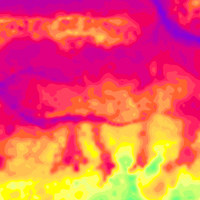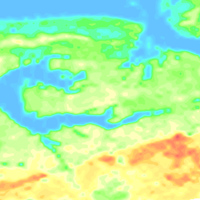Keyword
Hansestadt Hamburg
11 record(s)
Provided by
Type of resources
Available actions
Topics
Keywords
Contact for the resource
Service types
-
.png)
The WMS D-AERO (INSPIRE) comprises airborne geophysical surveys for mapping the shallow subsurface in Germany. Since the eighties BGR carries out helicopter borne measurements in Germany as well as in neighbouring and distant countries. In particular a series of continuous areas on the German North Sea coast are flown during the last years within the context of the D-AERO project. The helicopter of type Sikorsky S-76B is operated for the airborne geophysical survey of the earth's subsurface. Usually airborne electromagnetic, magnetic and radiometric measurements are carried out. According to the Data Specification on Geology (D2.8.II.4_v3.0, sub-theme Geophysics) the information with respect to the airborne geophysical surveys is INSPIRE-compliant. The WMS D-AERO (INSPIRE) contains for each airborne geophysical survey one layer, e.g. GE.flightLine.G081Cuxhaven. The flightlines are displayed correspondingly to the INSPIRE portrayal rules. Via the getFeatureInfo request, the user obtains the content of the INSPIRE attributes platformType und profileType. Additionally, the WMS contains a campaign layer (GE.airborneGeophysicalSurvey) with the INSPIRE attributes campaignType and surveyType.
-
.png)
Since the eighties BGR carries out helicopter borne measurements in Germany as well as in neighbouring and distant countries. In particular a series of continuous areas on the German North Sea coast are flown during the last years within the context of the D-AERO project. The helicopter of type Sikorsky S-76B is operated for the airborne geophysical survey of the earth's subsurface. Usually airborne electromagnetic, magnetic and radiometric measurements are carried out. The 13 GML files for each airborne geophysical survey area together with a Readme.txt file are provided in ZIP format (D-AERO-INSPIRE.zip). The Readme.text file (German/English) contains detailed information on the GML files content. Data transformation was proceeded by using the INSPIRE Solution Pack for FME according to the INSPIRE requirements of data specification Geology (D2.8.II.4_v3.0), Sub-theme Geophysics.
-

This dataset has been compiled within the BGR project "D-AERO-Auswertung" based on several survey area located along the German North Sea coast. The BGR helicopter (Sikorsky S-76B) is used for airborne geophysical surveying of the Earth’s subsurface. The standard equipment comprises the methods electromagnetics, magnetics and radiometrics. The passive magnetic (HMG) system consists of two Cesium magnetometers, which are located in the HEM flying tube (bird) about 40 m beneath the helicopter as well as in a base station on ground. The results are displayed as maps of the anomalies of the Earth's magnetic total field.
-

BGR conducted within the project „Airborne geophysical surveys for mapping the shallow subsurface in Germany “ (D-AERO) airborne surveys at the German North Sea coast. The survey area Glueckstadt (2009/10) follows the course of the river Elbe from the city of Hamburg in the southeast to the mouth of the river in the northwest. The size of the area is about 1950 km². The area was surveyed with 62 flights totalling to 8576 line-km (2,358,357 survey points). The nominal separation of the 209 E-W lines and 18 N-S tie lines was 250 m and 2500 m, respectively. The map displays the anomalies of the magnetic field of the earth.
-

This dataset has been compiled within the BGR project "D-AERO-Auswertung" based on several survey area located along the German North Sea coast. The BGR helicopter (Sikorsky S-76B) is used for airborne geophysical surveying of the Earth’s subsurface. The standard equipment comprises the methods electromagnetics, magnetics and radiometrics. The active multi-frequency, helicopter-borne electromagnetic (HEM) system, which consists of circular (diameter about 0.5 m) transmitter and receiver coils (horizontal separation about 8 m) operating at five and since 2007 at six system frequencies, is housed by a flying tube (bird) about 40 m beneath the helicopter. The HEM system used before 2002 consisted of rectangular coils (horizontal separation slightly less than 7 m) and five system frequencies (0.4 - 190 kHz). The ratio of received and transmitted signal yields to the electrical conductivity down to 50/150 m depth in case of conductive/resistive subsurface. The results are displayed as apparent resistivity (= half-space resistivity) and centroid depth maps at each of the six system frequencies ranging from 0.4 to 130 kHz.
-

This dataset has been compiled within the BGR project "D-AERO-Auswertung" based on several survey area located along the German North Sea coast. The BGR helicopter (Sikorsky S-76B) is used for airborne geophysical surveying of the Earth’s subsurface. The standard equipment comprises the methods electromagnetics, magnetics and radiometrics. The passive radiometric (HRD) system is installed into the helicopter and consists of a gamma-ray spectrometer with five Sodiumiodid detectors to measure the gamma radiation. The results are as maps displaying total count, exposure rate as well as (equivalent) concentrations of Potassium, Thorium and Uranium at ground level.
-

This dataset has been compiled within the BGR project "D-AERO-Auswertung" based on several survey area located along the German North Sea coast. The BGR helicopter (Sikorsky S-76B) is used for airborne geophysical surveying of the Earth’s subsurface. The standard equipment comprises the methods electromagnetics, magnetics and radiometrics. The active multi-frequency, helicopter-borne electromagnetic (HEM) system, which consists of circular (diameter about 0.5 m) transmitter and receiver coils (horizontal separation about 8 m) operating at five and since 2007 at six system frequencies, is housed by a flying tube (bird) about 40 m beneath the helicopter. The HEM system used before 2002 consisted of rectangular coils (horizontal separation slightly less than 7 m) and five system frequencies (0.4 - 190 kHz). The ratio of received and transmitted signal yields to the electrical conductivity down to 50/150 m depth in case of conductive/resistive subsurface. Horizontal resistivity (= inverse of conductivity) sections are derived at several depths from multi-layer inversion results (1D resistivity-depth models).
-

This dataset has been compiled within the BGR project "D-AERO-Auswertung" based on several survey area located along the German North Sea coast. The BGR helicopter (Sikorsky S-76B) is used for airborne geophysical surveying of the Earth’s subsurface. The standard equipment comprises the methods electromagnetics, magnetics and radiometrics. The active multi-frequency, helicopter-borne electromagnetic (HEM) system, which consists of circular (diameter about 0.5 m) transmitter and receiver coils (horizontal separation about 8 m) operating at five and since 2007 at six system frequencies, is housed by a flying tube (bird) about 40 m beneath the helicopter. The HEM system used before 2002 consisted of rectangular coils (horizontal separation slightly less than 7 m) and five system frequencies (0.4 - 190 kHz). The ratio of received and transmitted signal yields to the electrical conductivity down to 50/150 m depth in case of conductive/resistive subsurface. Horizontal resistivity (= inverse of conductivity) sections are derived at several depths from multi-layer inversion results (1D resistivity-depth models).
-

This dataset has been compiled within the BGR project "D-AERO-Auswertung" based on several survey area located along the German North Sea coast. The BGR helicopter (Sikorsky S-76B) is used for airborne geophysical surveying of the Earth’s subsurface. The standard equipment comprises the methods electromagnetics, magnetics and radiometrics. The active multi-frequency, helicopter-borne electromagnetic (HEM) system, which consists of circular (diameter about 0.5 m) transmitter and receiver coils (horizontal separation about 8 m) operating at five and since 2007 at six system frequencies, is housed by a flying tube (bird) about 40 m beneath the helicopter. The HEM system used before 2002 consisted of rectangular coils (horizontal separation slightly less than 7 m) and five system frequencies (0.4 - 190 kHz). The ratio of received and transmitted signal yields to the electrical conductivity down to 50/150 m depth in case of conductive/resistive subsurface. The results are displayed as apparent resistivity (= half-space resistivity) and centroid depth maps at each of the six system frequencies ranging from 0.4 to 130 kHz.
-

BGR conducted within the project „Airborne geophysical surveys for mapping the shallow subsurface in Germany “ (D-AERO) airborne surveys at the German North Sea coast. The survey area Glueckstadt (2009/10) follows the course of the river Elbe from the city of Hamburg in the southeast to the mouth of the river in the northwest. The size of the area is about 1950 km². The area was surveyed with 62 flights totalling to 8581 line-km (2,349,269 survey points). The nominal separation of the 209 E-W lines and 18 N-S tie lines was 250 m and 2500 m, respectively. The maps display the geophysical parameters apparent resistivity and centroid depth derived from the HEM data at the six frequencies of the HEM system (0.4 - 130 kHz). Furthermore, horizontal and vertical slices were derived from layered-earth models (resistivities and thicknesses of six model layers).
 www.geodatenkatalog.de (S1F)
www.geodatenkatalog.de (S1F)